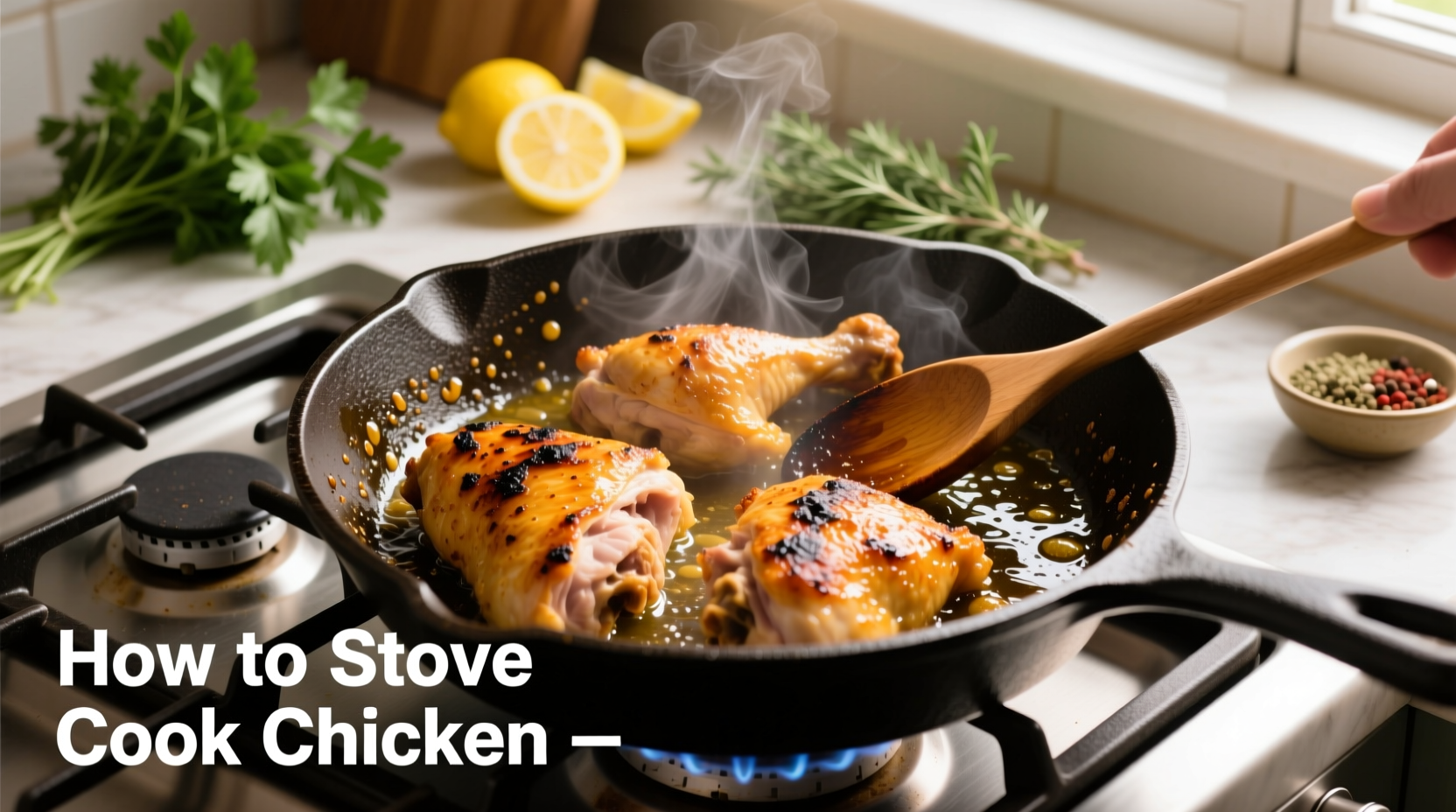Perfect stove-cooked chicken requires medium-high heat (375°F/190°C), a preheated skillet, and cooking to 165°F (74°C) internal temperature. Boneless breasts take 6-8 minutes per side, thighs 8-10 minutes. Always rest 5 minutes before slicing.
Mastering stove-top chicken transforms weeknight dinners with minimal equipment and maximum flavor. As a professional chef who's taught thousands of home cooks, I've refined this method to eliminate dryness and guarantee juicy results every time. Whether you're using boneless breasts, thighs, or drumsticks, the right technique makes all the difference in texture and taste.
Why Stove Cooking Beats Other Methods for Weeknight Meals
Stove-top cooking delivers superior browning and control compared to baking, with faster results than grilling. The direct heat creates that coveted golden crust while locking in juices. Unlike oven methods, you can monitor the process continuously and adjust heat instantly. For busy cooks, this technique typically takes 15-20 minutes from start to finish—perfect for quick, nutritious meals without sacrificing quality.
Essential Tools for Perfect Stove-Cooked Chicken
You don't need specialized equipment, but these items make a significant difference:
- Heavy-bottomed skillet (cast iron or stainless steel)
- Instant-read thermometer (critical for food safety)
- Tongs with silicone tips
- Meat mallet for even thickness
- Aluminum foil for resting
| Chicken Cut | Thickness | Stove Time | Rest Time |
|---|---|---|---|
| Boneless breasts | ¾ inch | 6-8 min per side | 5 minutes |
| Bone-in thighs | 1 inch | 8-10 min per side | 5 minutes |
| Drumsticks | 1½ inches | 10-12 min per side | 5 minutes |
| Wings | 1 inch | 12-15 min total | 3 minutes |
Step-by-Step Cooking Process: From Fridge to Plate
Preparation Phase (5 Minutes)
Remove chicken from refrigerator 20 minutes before cooking to reach room temperature—this ensures even cooking. Pat thoroughly dry with paper towels; moisture is the enemy of browning. For breasts, place between plastic wrap and gently pound thicker ends to uniform ¾-inch thickness using a meat mallet. Season generously with salt (1 teaspoon per pound) and pepper. The USDA Food Safety and Inspection Service confirms proper seasoning enhances both flavor and food safety by creating a protective surface layer (source).
Heat Management (Critical Step)
Preheat your skillet over medium-high heat for 3-4 minutes until a drop of water sizzles immediately. Add 1-2 tablespoons of high-smoke point oil (avocado, canola, or light olive oil). The oil should shimmer but not smoke. Professional kitchens maintain this precise temperature because exceeding 400°F causes bitter burnt proteins while below 350°F steams rather than sears.

Cooking Execution (8-12 Minutes)
Place chicken in hot skillet without crowding—work in batches if necessary. Listen for an immediate sizzle. For boneless breasts, cook 6-8 minutes per side; thighs 8-10 minutes. Resist the urge to move or check frequently—this disrupts crust formation. After flipping, press lightly with a spatula for even contact. When juices run clear and internal temperature reaches 165°F (74°C) at the thickest part, it's done. The American Institute for Cancer Research confirms this temperature destroys harmful bacteria while preserving moisture (source).
Troubleshooting Common Problems
Problem: Chicken sticks to the pan
Solution: Your pan wasn't hot enough before adding oil and chicken. Proper preheating creates the Maillard reaction that naturally releases food.
Problem: Uneven cooking
Solution: Pound breasts to uniform thickness and avoid moving chicken during initial sear. Rotate pieces if your burner heats unevenly.
Problem: Burnt exterior, raw interior
Solution: Heat was too high. Reduce to medium and finish cooking in a 350°F oven if necessary.
Flavor Variations for Different Cuisines
Mediterranean Style: Add lemon slices and fresh rosemary to the pan during the last 3 minutes of cooking. Deglaze with ¼ cup chicken broth after removing chicken.
Asian-Inspired: Marinate 30 minutes in 2 tablespoons soy sauce, 1 tablespoon honey, and 1 teaspoon grated ginger before cooking. Finish with sesame seeds and green onions.
Spicy Cajun: Coat chicken in 1 tablespoon Cajun seasoning before cooking. Add sliced bell peppers and onions to the pan after removing chicken for a quick vegetable side.
When Stove Cooking Isn't Ideal: Context Boundaries
While stove-top cooking excels for most weeknight meals, certain situations call for alternative methods:
- Large gatherings: Oven roasting handles multiple pieces simultaneously
- Whole chicken: Requires roasting for even cooking
- Meal prep: Poaching yields more consistent results for salads
- Extremely lean cuts: Bone-in pieces retain moisture better on stove
The FDA Food Code specifies that poultry must reach 165°F internal temperature regardless of cooking method to ensure safety (source).
Proper Resting and Slicing Techniques
Transfer cooked chicken to a clean cutting board and tent loosely with foil for 5 minutes. This allows juices to redistribute—skipping this step causes 20-30% moisture loss when slicing. For maximum tenderness, slice against the grain at a 45-degree angle. Breast meat should yield clean slices without shredding; thighs will naturally separate along connective tissue.
Storage and Reheating Guidelines
Cool cooked chicken within 2 hours and store in airtight containers for up to 4 days. For best reheating results, place slices in a covered skillet with 1 tablespoon broth over low heat for 3-4 minutes, turning once. Microwave reheating often dries out chicken—add a damp paper towel if using this method.











 浙公网安备
33010002000092号
浙公网安备
33010002000092号 浙B2-20120091-4
浙B2-20120091-4